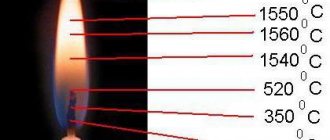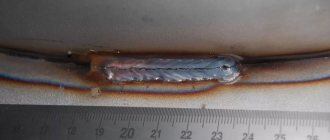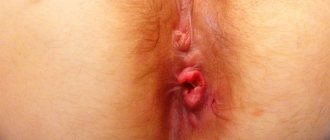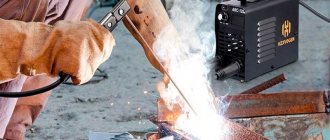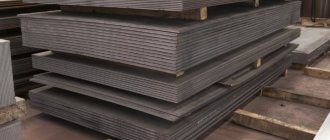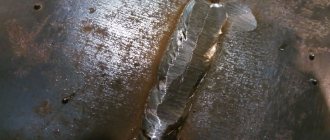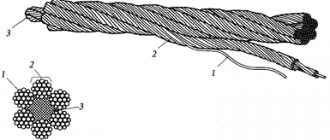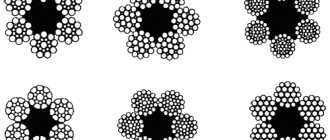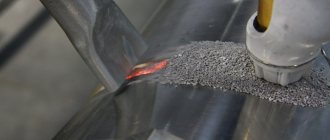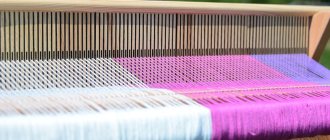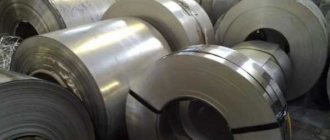What are stresses and strains?
The appearance of stress and distortion is accompanied by any force applied to a metal product. The force that exerts pressure per unit area is called stress, and the violation of the integrity of shapes and sizes as a result of force load is called deformation.
Stress can be caused by physical force of a compressive, tensile, shearing or bending nature. When welding stresses and deformations exceed permissible values, this entails the destruction of individual elements and the entire structure.
Why are deformations and stresses formed?
Deformations during welding appear due to internal stresses caused by various factors. The causes of such violations are conventionally divided into two large categories: the main (inevitable) ones, which are always present during welding work, and the accompanying ones, which must be eliminated.
The reasons are inevitable
The main group consists of the following causes of stress and deformation during welding: structural modifications that provoke the development of compressive and tensile stresses. Quite often, when cooling products made from high-carbon and alloyed steel alloys, the grain structure of the metals and the dimensions of the parts themselves are disrupted.
As a result, the initial volume of the metal changes, which actually increases the internal stress;
- uneven heating . During the welding process, only the involved area of the metal is heated, while it expands and affects less heated layers. The high stress concentration in welded joints resulting from intermittent heating mainly depends on the linear expansion indicators, the degree of thermal conductivity and temperature conditions. The higher these indicators, the lower the thermal conductivity of the metal and, accordingly, the risks of inaccuracies in the welding seam increase;
- casting shrinkage , when the volume of the metal decreases noticeably due to its crystallization. This is explained by the fact that in the molten metal, under the influence of shrinkage, a welding stress is formed, which can be both transverse and longitudinal.
Not only external force influences can provoke stress during welding. Metal alloys are also characterized by their own stresses and deformations, which are divided into residual and temporary. The former arise due to plastic deformation and even after cooling the structure they remain in it. When do temporary welding deformations appear? Directly during the welding process in a firmly fixed product.
Associated causes
In addition to the main ones, there are also secondary causes of deformation during welding. These include:
- deviation from technological standards, for example, the use of electrodes that are not suitable for a particular case, violation of welding conditions, insufficient preparation of the product for the welding process, and others;
- inconsistency of design solutions: frequent intersection of welded joints or insufficient distance between them, inaccurately selected type of seam, etc.;
- lack of experience and relevant knowledge of the welder.
Which of the following causes stress concentration in welded joints? Any incorrect action leads to technological defects in the seam, in particular to the appearance of cracks, bubbles, lack of fusion and other defects.
Reasons for appearance
The main causes of stress and welding deformation are:
- non-uniform heating of metal workpieces;
- shrinkage changes in the alloy in the weld;
- phase changes that occur during the transition of molten metal from one state to another.
One of the properties of metals is their ability to expand when the temperature rises and contract when cooled.
During melting, a non-uniform thermal zone appears in the area of the welding joint. It causes compressive or tensile stress. If these stresses exceed the yield strength of the metal, then the shape of the product changes and residual deformations occur.
The types of deformations depend on the extent to which they occur. There are three genera. Deformations of the first kind act in macrovolumes, deformations of the second kind occur within crystal grains, and deformations of the third kind occur in the crystal lattice of the metal.
Deformations and stresses during welding also occur during crystallization of the weld, when shrinkage of the liquid metal occurs. The volume of cooling liquid metal decreases, this causes stress inside the metal. Stresses are formed parallel and perpendicular to the axis of the weld seam, which cause a change in the shape of the product. Longitudinal forces cause changes in the length of the weld, and transverse forces lead to angular deformations.
When certain limiting temperatures are exceeded when welding carbon and alloy steels, their structural transformation occurs. They have a different specific volume and the coefficient of linear expansion changes, which leads to enormous welding stresses.
The largest of these occur in alloy steels. Hardening structures are formed in them, which, when cooled, do not return to the previous structure of the metal, as in most cases, but retain colossal stresses that can lead to the destruction of the weld.
For these alloys, special technological processes are being developed to reduce residual stresses and deformations.
Types of deformations and stresses
There are different types of stress depending on the nature of their occurrence, period of action and other factors. The table below shows what causes stress concentrations in welded joints and what they are.
| Nature of occurrence | Voltage type | What caused the violation |
| According to the reason for the appearance | Thermal | Uneven heating due to temperature differences during the welding process |
| Structural | Changes in the structure of the metal when heated above the maximum permissible temperature | |
| By lifetime | Temporary | Formed during phase changes, but gradually disappear due to cooling |
| Residual | Even after eliminating the causes of their appearance, they are present in the product | |
| By area covered | Operating throughout the entire structure | |
| Acting only in the grains of the material structure | ||
| Present in the crystal lattice of the metal | ||
| By direction of action | Longitudinal | Formed along the weld line |
| Transverse | Positioned perpendicular to the axis of the connection | |
| By type of tension | Linear | Effect extends in only one direction |
| Planar | Formed in two different directions | |
| Volumetric | Have a three-way effect at the same time | |
There are types of deformations during welding:
- local and general . The first ones occur in separate areas and change only part of the product. The second leads to a change in the size of the entire structure and curvature of its geometric axis;
- temporary and final . Welding deformations that occur at a particular moment are called temporary, and those that remain in it after complete cooling of the product are called residual;
- elastic and plastic . When, after welding, the size and shape of the structure are completely restored, the deformation is elastic; if defects remain, it is plastic.
Metal deformations are possible both in the plane of the welded structure and outside it.
Influence of metal structures
With ultra-fast heating, structural changes occur in any metal.
They are caused by the fact that the constituent microstructures of any metal have different grain sizes.
In relation to unalloyed medium- and low-carbon steels (steels with a high carbon content are known to be poorly welded), at different temperatures, mainly the following structures can form in them:
- Austenite is a solid solution of carbon in α-iron. It is formed at heating temperatures above 7230C, and exists, depending on the percentage of carbon in the steel, up to temperatures of 1100-13500C. The mobility of microstructure grains under such conditions is high, therefore austenitic steels are quite plastic and, when cooled slowly, do not have a significant level of residual stresses. Partially (up to 18-20%) austenite is retained in the steel structure after final cooling. The austenite grain sizes are 0.27-0.8 microns.
- Iron carbide/cementite . The structure has a diamond-shaped lattice and is characterized by high surface hardness. Grain sizes are in the range of 0.1-0.3 microns.
- Ferrite is a low-temperature, softest component of the microstructure, formed during the process of relatively slow cooling of the metal, which occurs during submerged arc welding. Ferrite grains are round in plan, 0.7-0.9 microns in size.
- Pearlite is a structure that is formed during the cooling of the metal and is a mixture of ferrite and cementite. Depending on the cooling rate, perlite can be granular or lamellar. In the first case, the grains are elongated along the axis of the workpiece, in the second they have a rounded shape. The average particle size of perlite is in the range of 0.6-0.8 microns. At increased cooling rates, instead of perlite, a finer structural component appears, which is called troostite. Troostite grain sizes do not exceed 0.2 microns.
- Martensite is a nonequilibrium structural component that exists only in steel heated to temperatures above 750-9000C (with an increase in the percentage of carbon, the beginning of the martensitic transformation shifts to lower temperatures). It is fixed in the steel composition only during its accelerated cooling, for example, during hardening. This martensite has a grain size of 0.2-2.0 microns.
Alloy steels have an even more complex composition, in the microstructure of which carbides and nitrides appear. In addition, the grain sizes are strongly influenced by the cooling rate of various parts of the parts, the composition of the atmosphere in which heating is carried out, the intensity of diffusion of the welding electrode material, etc.
Thus, the main reason for the occurrence of stresses in welded structures is the sharply different grain sizes in the microstructure of steels.
Weld testing and deformation calculations
In order to determine the strength and reliability of the seam, and to identify any defects that have arisen, testing of welded joints is carried out. Such control allows you to detect defects in a timely manner and promptly eliminate them.
To identify flaws, the following types of control are used:
- destructive _ Allows you to study the physical qualities of the weld; they are actively used in manufacturing enterprises;
- non -destructive It is carried out through external inspection, capillary method, magnetic or ultrasonic flaw detection, permeability control and other methods.
When producing structures using welding, one of the important nuances is the accurate determination of possible deformations and stresses. Their presence leads to deviations from the original dimensions and shapes of products, reduces the strength of structures and impairs performance.
Calculation of welding stresses and deformations allows you to analyze different options for carrying out welding operations and plan their sequence so that during the work the structure is subjected to minimal stresses and the formation of defects.
Methods for eliminating welding stresses
To eliminate stress, annealing is carried out or mechanical methods are used. Annealing is considered the most progressive and effective. The method is used in cases where extremely high demands are made on the geometric accuracy of all product parameters.
Annealing can be general or local. In most cases, the procedure is carried out at a temperature of 550-680°C. The whole process is carried out in three stages: heating, holding and cooling.
The most commonly used mechanical methods are rolling, forging, vibration techniques and explosion processing. Forging is carried out using a pneumatic hammer. For vibration processing, vibration-inducing devices are used, which have a resonant frequency of 10-120 Hz for several minutes.
Methods for eliminating deformation
Metal deformation during welding is eliminated by thermomechanical, cold mechanical and thermal straightening with general or local heating. When fully annealed, the structure is firmly fixed in a special device, which applies pressure to the required areas. After fixing, the product is placed in an oven for heating.
The principle of the thermal method is that during the cooling process the metal contracts. The stretched area is heated using an arc or torch in such a way that the surrounding alloy remains cold. This prevents the hot spot from expanding too much. During the cooling process, the structure straightens. The method is ideal for straightening sheet strips, beams and other products.
Cold straightening is carried out using constant loads, which are formed using various presses and rolls for rolling long structures. In highly stretched structures, thermal straightening is used to eliminate deformations. First, excess metal is collected, after which the problem areas are heated.
Which method is considered the best? There is no clear answer here. When choosing a technology, one should take into account the type, size and shape of the metal product, what features caused the deformations and welding stresses, and the deformations that occurred in the plane or outside. It is also worth paying attention to the effectiveness of the technique and the upcoming labor costs.
Metal deformation during welding: causes and ways to eliminate them
25 August 2022 Metal deformation during welding: causes and ways to eliminate them
Issues discussed in the material:
- Causes of metal deformation during welding
- Types of metal deformations after welding
- On testing welds and calculating metal deformations during welding
- Methods for eliminating metal deformation during welding
- Ways to avoid metal deformation when welding
Metal deformation during welding is a phenomenon that leads to a violation of the geometry of products and, consequently, to defective products. This can be observed even in the work of experienced welders. Compliance with a number of rules allows you to reduce the likelihood of deformation and obtain a high-quality and reliable connection.
There are many reasons for metal deformation during welding. Read about what they are connected with, what measures are taken to prevent this phenomenon and what they are doing to correct it in our material.
Causes of metal deformation during welding
If a metal object is subjected to mechanical stress, stress and distortion occur in it. The first is characterized by the force of pressure exerted per unit area. The second is a violation of the dimensions and shape of the product due to force.
Stresses appear in parts under the influence of almost any effort. This may be stretching, bending, squeezing or cutting. During welding, both strain and stress values should be closely monitored. If the permissible values are exceeded, the structure (partially or completely) may collapse.
Welding deformations arise under the influence of various types of stresses appearing inside the product. Experts combine the main reasons for their appearance into two large groups: the main ones, which are considered inevitable and constantly appear during welding, as well as accompanying ones, the elimination of which is quite possible.
The main causes of deformation and stress during welding include the following:
- Structural modifications that, affecting the metal, cause stress (tensile and compressive). This happens during the cooling of parts made of alloy or high-carbon steel alloys. In this case, the dimensions of the product, as well as the grain structure of the material, are disrupted. As a result, the initial volume changes, which leads to an increase in stress inside the part.
- Uneven heating. Only the working area of the product is subject to primary heating during welding. As the temperature increases, the material expands, affecting slightly heated layers of metal. With intermittent heating, the stress concentration of the weld reaches high values. Its indicator depends on the operating temperature, thermal conductivity of the material and the level of linear expansion.
- Foundry shrinkage. It occurs during crystallization of the material, is characterized by a decrease in the volume of the metal, and occurs due to welding stress (longitudinal and transverse), which appears during the process of melt shrinkage.
Welding stress can be caused not only by mechanical influences. Alloys of various metals generally have their own deformations and stresses. They are divided into temporary and residual. Plastic deformation of the metal during welding causes residual deformation that does not disappear even after the material cools. Temporary ones occur when welding a firmly fixed part.
Incidental or accompanying deformations during welding include:
- any deviations from the standards in the technological process - an example could be poor preparation of the part for welding, incorrect choice of electrode, violation of the welding process, etc.;
- inconsistencies and errors made in the design of the product - these may be an incorrectly selected type of seam, frequently located joints, a small gap between welds, etc.;
- low professionalism and little experience of the master.
Almost any error can cause stress concentration in a weld. Because of them, technological defects in the connection arise: lack of penetration, cracks, bubbles and other defects.
Types of metal deformations after welding
There are several types of stress. They differ in time interval (period of action), nature of appearance and other factors.
Below is a table of possible stresses (which ones occur and why they appear in the weld).
| Nature of appearance | Voltage type | Reason for violation |
| For reasons of occurrence | Thermal | Uneven heating resulting from temperature changes during welding |
| Structural | If the metal is heated above the maximum set temperature, changes occur in the structure of the material | |
| By lifetime | Temporary | Appears during phase modifications, but goes away during cooling |
| Residual | Remains in detail even after the causes of occurrence have been eliminated | |
| By area involved | Available in all designs | |
| Appears exclusively in the grains of the metal structure | ||
| Present in the crystal lattice of a material | ||
| By direction of impact | Longitudinal | Appears along the seam line |
| Transverse | Placed across the axis of the connection | |
| According to voltage status | Linear | Only happens in one direction |
| Planar | Spreads in two different directions | |
| Volumetric | Impact occurs along three axes |
During the welding process, the following types of deformation occur:
- Local and general. With local deformations, only parts of the structure are subject to changes. General ones deform the product completely and immediately, changing its dimensions and bending the geometric axis.
- Temporary and final. Residual (final) deformations remain in the product even after it has cooled, while temporary ones appear at certain points in time.
- Elastic and plastic. When the shape and dimensions of the product are restored after welding is completed, the deformation is considered elastic. In the presence of permanent defects - plastic.
The material can be deformed outside the plane of the welded product or inside it.
The multidirectionality of forces acting relative to the cross-section of the material leads to the emergence of various stresses: compression or bending, tension, torsion, shear.
Testing of welds and calculation of metal deformations during welding
Seams must be tested for reliability and strength of connections. During the inspection, the presence of defects is also checked. This allows you to quickly detect and eliminate defects that arise during the welding process.
There are several types of control that allow you to find flaws:
- destructive - a process that is often used in industrial enterprises, makes it possible to test the physical properties of the seam;
- non-destructive - includes external inspection of the seam, ultrasonic or magnetic flaw detection, capillary method, permeability testing and other methods.
It is important in the manufacture of welded structures to determine the likely stresses and deformations during work. The reason is that they change the shape and size of the product, reduce its strength, which leads to changes in the performance of the structure that are far from for the better.
It is necessary to carefully calculate the deformations and stresses during various welding processes, to correctly plan the sequence of operations so that as a result, a minimum of stress is applied to the structure, and the number of defects tends to zero.
Methods for eliminating metal deformation during welding
Deformation of the material that occurs during welding can be removed by straightening. It can be cold mechanical, thermomechanical and thermal, including both local and general heating. Before carrying out the latter, the product is rigidly fixed in a device that exerts pressure on the variable parts of the structure. It is then placed in a preheating oven.
The essence of the thermal method is to compress the metal as it cools. The process of heating the stretched area with a torch or arc occurs.
At the same time, the material surrounding the heating area must remain cold, which prevents the hot area from expanding significantly. Then, as the product cools, the structure gradually straightens.
This method is most suitable for eliminating deformations of beams, strips of sheet material, etc.
The principle of cold straightening is the constant impact of loads on the product. For this purpose, various presses and rollers are used, which exist for rolling long structures along them. To correct deformations of tensile structures, thermal straightening is used. First, excess metal is collected, and then the problem area is heated.
It is difficult to say which method is preferable. For each type, location (outside or inside), characteristics of deformation and stress, as well as dimensions and shape of the product, there are ways to eliminate them. The labor costs and effectiveness of the method are important.
How to prevent stress and strain
To improve the quality of structures and prevent the formation of defects, you should know what determines the amount of deformation of the metal being welded.
You can reduce stress during welding and prevent deformation if you adhere to the following rules:
- when designing a welded structure, you first need to calculate the welding deformations, which will allow you to correctly form the sections of the seams and provide the necessary allowances for shrinkage in certain areas of the product;
- the seams must be made symmetrically to the profile axes of the entire product and its individual parts;
- it is very important that there are no intersections of more than three seams at one point;
- before welding, the structure must be checked for compliance with the calculations of the gaps in the joints and overall dimensions;
- Residual deformation can be reduced by creating an artificial deformation in the joint that is opposite in sign to the welding being performed. For this purpose, general or local heating of the structure is used;
- when making long seams, use the reverse-step method for passing;
- use heat-dissipating pads or cooling mixtures that can reduce the heating zone;
- apply seams in such a way that the subsequent connection causes the opposite deformations from the previous seams;
- select welding techniques for ductile metals that can reduce the final deformations.
It is necessary to understand, in order to minimize deformations during welding, the causes of their occurrence and preventive measures are directly related to each other. Therefore, first you need to carry out all the calculations and preparatory work, and only after that begin the process of welding metal structures.
Methods to counteract welding deformations and stresses
It is much easier to prevent a problem than to fix it. This also applies to welding work. In order not to have to deal with the elimination of defects, as well as to avoid unnecessary financial costs, you should pay attention to some measures to combat welding stresses and deformations.
Follow-up and preheating
Performing such types of heating improves the quality characteristics of the seam and adjacent areas. The method also helps to reduce residual stress and plastic deformation. Heating is used for steels prone to crystallization cracks and hardening.
Stitching in reverse step order
If the length of the seam exceeds 1000 millimeters, then it should be divided into separate sections of 100-150 mm each, and they should be directed opposite to the direction of welding. The use of this method makes it possible to achieve uniform heating of the metal and significantly reduce deformation, which cannot be attributed to the case of sequential application.
Forging seams
Both cold and heated metal can be forged. The force of the impact causes the metal to expand in different directions, thus reducing the tensile stress. If the structure is created from a metal prone to the appearance of hardening structures, then forging is not performed on such products.
Straightening out deformations
The essence of the method is to select the order in which the seams are made. In this case, each subsequent seam must create counteracting deformation to the previous connection. This is very important when welding double-sided joints.
Rigid fastening of parts
During the entire welding process, the workpieces must be firmly and firmly secured in the jigs. Remove only after complete cooling. It should be noted that this method has one drawback - an increased risk of internal stresses.
Heat treatment
Improves the mechanical characteristics of the seam and adjacent areas, aligns the structure of the joint, and reduces internal stresses. Heat treatment consists of different operations: tempering, annealing (full or low temperature), normalization.
Normalization is considered the best processing method for welded products; the method is especially suitable for products made of low-carbon steels.
Gas cutter (profession). Test with answers (2021) - option 71
content .. 69 70 71 72 ..Question No. 1
What welding deformations are called residual? — Deformations that appear during welding — Deformations that appear after welding (+)
— Deformations formed under the influence of operational loads
Explanation: Sokolov I.I. Gas welding and cutting. page 118
Question No. 2
Within what radius from sludge storage areas is smoking and the use of open fire prohibited? — 3 m — 5 m — 10 m (+) — 20 m
Explanation: POT R M-020-2001
Question No. 3
What determines the amount of deformation of the metal being cut? — From the tendency of the metal to harden — From uneven heating (+)
- From the brand of electrode used for welding
Explanation: Sokolov I.I. Gas welding and cutting. page 129
Question No. 4
What determines the choice of specific types of personal protective equipment? — On the type of work (+) — Substances used (+) — Materials used (+)
Explanation: POT R M-020-2001 clause 2.21.2
Question No. 5
Signs of carbon monoxide poisoning. - Sudden weakness, dizziness, unsteady gait, convulsions, tinnitus - Headache, palpitations, weakness, vomiting, weakening of cardiac activity and breathing, unconsciousness (+)
— Headache, palpitations, weakness, vomiting, convulsions, tinnitus
Explanation: Kulikov O.N. Occupational safety during welding work. Page 166.
Question No. 6
What are the main characteristics accepted for assessing the mechanical properties of metals? — Tensile strength, yield strength, elongation and contraction, impact strength, hardness, static bending resistance (+)
— Heat resistance, heat resistance and cold resistance of metal — Mechanical aging, fatigue resistance, shear resistance
Explanation: Sokolov I.I. Gas welding and cutting p.114
Question No. 7
What color is the outer surface of argon cylinders painted? — Black color with a brown stripe — Black color — Gray color with a green stripe (+)
— Blue
Explanation: PB 03-576-03 tab.17
Question No. 8
What color is the outer surface of nitrogen cylinders painted? — Black with brown stripe (+)
— Black color — Gray color with green stripe — White color
Explanation: PB 03-576-03 tab.17
Question No. 9
What must be provided (if necessary) to ensure the capture of welding aerosols directly at the point of their formation when carrying out welding work in enclosed spaces? — Local suction (+) — General ventilation (+)
— Filters that prevent the release of harmful substances into the environment — Cleaning the metal surface 5 cm from the welding site
Explanation: POT R M-020-2001 clause 2.14.2
Question No. 10
What color is the body of a flammable gas cylinder painted? — Black — Red (+)
— Blue — Dark green
Explanation: PB 03-576-03 tab.17
Question No. 11
What signal color does the “Attention” safety sign represent? — Red — Yellow (+)
— Green — Blue
Explanation: Kulikov O.N. .page 101
Question No. 12
How often is the “closed-open” state of the station water seal checked when using a dry seal? — 1 time per shift — 2 times per shift — 3 times per shift — At least 3 times per shift (+)
Explanation: POT R M-020-2001 clause 2.15.9
Question No. 13
What color is the outer surface of carbon dioxide cylinders painted? — Black color with a brown stripe — Black color (+)
— Gray color with green stripe — White color
Explanation: PB 03-576-03 tab.17
Question No. 14
What determines the stability of the process and the quality of the cut parts? — Flame power — Cutting speed (+)
— Cutting positions — Cutting oxygen pressure
Explanation: Sokolov I.I. Gas welding and cutting. p.124
Question No. 15
Indicate the action that should be performed first when providing first aid in the event of an open fracture. — Apply a bandage (+)
— Fix the surface using folding splints — Apply a splint — Place a roll of clothing under your knees
Explanation: Interindustry instructions for first aid in case of accidents p. 34
Question No. 16
Who should disassemble and repair cylinder valves in case of malfunctions? — Welder — Workshop (factory) — filler (+)
— User — Locksmith — repairman
Explanation: Lupachev V.G. Gas welding. p.380
Question No. 17
Which of the following is prohibited when providing first aid to a victim if he is lying in the “frog” position? — Fix the limb using splints (+)
— Place a cushion of clothing between your legs — Fix the hip bones — All of the above actions are allowed
Explanation: Interindustry instructions for first aid in case of accidents p. 35
Question No. 18
At what distance is it allowed to carry out metal cutting work using propane-butane or natural gas, as well as open fire from groups of cylinders intended for gas-flame work? — At least 5 m (+)
— 10 m — No more than 5 m — No less than 10 m
Explanation: Lupachev V.G. Gas welding. 17.1 p.379
Question No. 19
What about the incident? — Destruction of the structure — Release of the environment — Deviation from the technical process mode (+)
— Uncontrolled explosion
Explanation: Federal Law on Industrial Safety, Art. 1
Question No. 20
What impurities of elements are constantly contained in carbon steel? — Aluminum, manganese, sulfur, titanium — Manganese, silicon, sulfur, phosphorus (+) — Silicon, copper, sulfur, phosphorus
Explanation: G.G. Chernyshov. Welding and cutting of metals. p.69
Question No. 21
Indicate which weld shape is preferable for fillet and T-joints with full penetration? — The shape of the seam is not significant — Normal and concave seams are preferred (+)
— Convex seams are preferred — The welder chooses the shape of the seam at his discretion
Explanation: Lupachev V.G. Gas welding. p.26
Question No. 22
At what distance is it allowed to carry out metal cutting work using propane-butane or natural gas, as well as open fire from gas pipelines of flammable gases, as well as gas disassembling stations located in metal cabinets during mechanized work? — 1.5 m (+) — 3 m — 5 m — 10 m
Explanation: POT R M-020-2001 clause 2.15.30
Question No. 23
Basic parameters of oxygen-arc cutting mode? — Preheating flame power (+) — Cutting oxygen pressure (+) — Cutting speed (+)
Explanation: Sokolov I.I. Gas welding and cutting. p.123
Question No. 24
What are the requirements for securing gas-conducting hoses to the connecting nipples of equipment, burners, cutters and reducers? — Must be reliable — Must be done using clamps — The hoses can be secured in at least two places along the length of the nipple with soft annealed (knitting) wire (+)
— Attach the hoses to the nipples of the water valves
Explanation: POT R M-020-2001 clause 2.15.28
Question No. 25
What actions should be performed at the scene of an incident when treating a burn without compromising the integrity of the burn blisters? — Place under running cold water for 10-15 minutes (+) — Apply cold for 20-30 minutes (+)
— Lubricate with oils and fats — All of the above actions are incorrect
Explanation: Instructions for first aid in case of accidents p. 30
Question No. 26
Which of the following actions should be performed first in cases of arterial bleeding in a victim? — Remove from clothing — Press the artery with your fingers or fist (+)
— Apply cold — Call an ambulance
Explanation: Interindustry instructions for first aid in case of accidents p. 21
Question No. 27
When repairing a hose, how should its individual pieces be connected? — Using sections of smooth tubes — Special nipples (+)
— Wrapping with insulating tape — All of the above are true
Explanation: Sokolov I.I. Gas welding and cutting. p.292
Question No. 28
What are the dangerous and harmful production factors in the welding process? — Solid and gaseous toxic substances in the welding aerosol (+) — Intense radiation from the welding arc in the optical range (+) — Intense thermal radiation from the products being welded and the weld pool (+)
Explanation: POT R M-020-2001 clause 1.2.1
Question No. 29
At what distance should live wires be located from the acetylene generator and cylinders? — 1 m — 3 m — 5 m (+)
Explanation: POT R M-020-2001 p 2.18.22
Question No. 30
What color or color stripes should the oxygen cylinder sleeves have? — Blue (+)
— Red — Yellow — Green
Explanation: Sokolov I.I. Gas welding and cutting. p.98
Question No. 31
What is boiling steel? — Containing no more than 0.07% silicon, not completely deoxidized during smelting (+)
— Heated to a temperature of over 1000° C — Containing more than 10 ml of hydrogen per 100 g of metal
Explanation: G.G. Chernyshov. Welding and cutting of metals. p.69
Question No. 32
What does the term “coma state” mean in a victim? - No consciousness, but there is a pulse in the carotid artery (+)
— There is consciousness, but the pulse in the carotid artery is difficult to hear — There is no consciousness and there is no pulse in the carotid artery — There is consciousness, and there is a pulse in the carotid artery
Explanation: Interindustry instructions for first aid in case of accidents p. 73
Question No. 33
What types of safety glasses should gas cutters and gas welders be provided with during manual and mechanized gas cutting? — Must be provided with closed-type safety glasses with TS-2 grade glasses, having light filters with a density of GS-3 (+) — Must be provided with open-type safety glasses with TS-2 grade glasses, having light filters with a GS-2 density (+)
— Must be provided with closed-type safety glasses with glasses of the TS-2 brand, having light filters with a density of G-1
Explanation: POT R M-020-2001 clause 2.21.7
Question No. 34
What is the procedure for providing first aid in an accident? — Assess the condition of the victim (presence or absence of a pulse and consciousness) (+) — If there is no pulse and consciousness, begin resuscitation immediately (+) — In case of arterial bleeding, apply a tourniquet (+) — If there are wounds, apply bandages (+) — If there are signs of fractures of the bones of the extremities, apply splints (+)
Explanation: Interindustry instructions for first aid in case of accidents p.5
Question No. 35
What are the first aid procedures for burns to the eyes or eyelids due to exposure to caustic chemicals? — Carefully spread the eyelids with your fingers and place them under a stream of cold water (+) — Rinse the eye under a stream of cold water so that it flows from the nose outward (+)
— Use neutralizing liquid — All of the above steps are correct
Explanation: Interindustry instructions for first aid in case of accidents p. 33
Question No. 36
What happens to the plastic properties of steel at subzero temperatures? — Increase — Decrease (+)
— Temperature has no effect
Question No. 37
Indicate into which groups metals are divided? — Group of precious and semi-precious — Group of light and heavy — Group of black and colored (+)
Explanation: Sokolov I.I. Gas welding and cutting.
Question No. 38
Specify the requirements for movement in the “step” voltage zone. — Move in dielectric boots — Move in dielectric galoshes — Move in a “goose step” — All of the above are true (+)
Explanation: Interindustry instructions for first aid in case of accidents p.43
Question No. 39
Indicate which of the listed properties of metals are physical? — Hardness, ductility, elasticity, viscosity — Corrosion resistance, heat resistance, scale resistance — Thermal conductivity, density, melting point, thermal expansion
(+)
Question No. 40
At what height, in accordance with GOST 12.4.059, workplaces must be equipped with fences? — Located above 1 m — Located above 1.3 m (+)
— Located above 2 m — Located above 2.5 m
Question No. 41
What determines the type of edge cutting? — Possibility of welding at minimum currents — Possibility of welding at maximum currents — Ability to ensure complete penetration and a minimum amount of deposited metal (+)
Explanation: Sokolov I.I. Gas welding and cutting. page 15
Question No. 42
Propane-butane cylinders are available in capacities... - 40-60 liters - 12-55 liters - 50-80 liters (+)
Explanation: Kulikov O.N. Occupational safety during welding work. Page 132.
Question No. 43
At what distance is it allowed to carry out metal cutting work using propane-butane or natural gas, as well as open fire from gas pipelines of flammable gases, as well as gas disassembling stations located in metal cabinets during manual work? — 1.5 m — 3 m (+)
— 5 m — Less than 5 m
Explanation: POT R M-020-2001 clause 2.15.30
Question No. 44
The concept of “dangerous zone” - An area where dangerous mechanisms are located - A space in which a person can be exposed to a dangerous and (or) harmful factor (+)
— The space where production activities take place
Explanation: Kulikov O.N. Occupational safety during welding work. p.4
Question No. 45
In what position can a victim be punched in the sternum when resuscitating him in a confined space? — In the victim’s position “sitting” (+) — In the victim’s position “lying” (+)
— In the position of the victim “lying on his back” on a flat, hard surface — In any position
Explanation: Interindustry instructions for first aid in case of accidents p. 16
Question No. 46
What signal color does the safety sign “Safety”, “Permission” indicate? — Red — Yellow — Green (+)
- Blue
Explanation: Kulikov O.N. p.101
Question No. 47
How should you extinguish an acetylene fire? — Water — Carbon dioxide fire extinguishers (+) — Dry sand (+)
- All of the above are true
Explanation: Kulikov O.N. Rolin E.I. Labor protection during welding work p. 131
Question No. 48
What is unacceptable when providing first aid to a victim in case of electric shock? — It is unacceptable to touch the victim without first disconnecting the power (+) — Stop resuscitation measures until signs of biological death appear (+)
— Pull the victim by his clothes at least 8 m
Explanation: Interindustry instructions for first aid in case of accidents p. 47
Question No. 49
Steel is an alloy of iron and carbon with carbon content... - Up to 1% - Up to 1.7% - Up to 2.14% (+)
— Up to 2.5% — Up to 3%
Explanation: G.G. Chernyshov. Welding and cutting of metals. p.283
Question No. 50
What is the name of the law that defines the legal, economic and social basis for ensuring the safe operation of hazardous production facilities? — Federal Law “On Industrial Safety of Production Facilities” — Federal Law “On Industrial Safety of Hazardous Production Facilities” (+)
— Federal Law “On the Safety of Production Facilities” — Federal Law “On Labor Protection at Hazardous Production Facilities”
Explanation: Federal Law on Industrial Security
Question No. 51
How are hand cutters classified? — By the type of flammable gas (+) — By the principle of mixing the combustible gas on which they operate (+) — By purpose (+) — By type of cutting (+)
Explanation: Sokolov I.I. Gas welding and cutting. page 141
Question No. 52
Who is responsible for ensuring a safe working environment and compliance with applicable safety regulations? — Welder — Employer (+)
— Public control — Head of welding works
Explanation: POT R M-020-2001 clause 1.1.3
Question No. 53
In what places is it permitted to cut metal using propane-butane mixtures? — In open areas (+) — In workshop premises (+)
— In confined spaces — In hard-to-reach spaces
Explanation:
Question No. 54
In what position should a victim with a penetrating abdominal wound be in while awaiting help and during transportation? — In the “lying on your back” position with your legs raised and bent at the knees (+)
— In the “sitting” position — In the “lying on his stomach” position — In any of the listed positions
Explanation: Interindustry instructions for first aid in case of accidents p. 29
Question No. 55
Within what radius from the point where the electric wire touches the ground is there a risk of being exposed to “step” voltage? — 8 m (+) — 10 m — 12 m — 20 m
Explanation: Interindustry instructions for first aid in case of accidents p. 42
Question No. 56
Is it possible to carry out welding work in close proximity to flammable and flammable materials? — With the permission of the administration — Yes — No (+)
- Of necessity
Explanation: POT R M-020-2001 clause 2.19.6
Question No. 57
What is a “harmful production factor”? — Production factor, the impact of which on an employee can lead to illness (+)
— A production factor, the impact of which on a worker can lead to injury — A production factor that has little impact on the employee
Explanation: Kulikov O.N. Occupational safety during welding work. page 4
Question No. 58
What pressure should be in a filled acetylene cylinder? — 150 kgf/sq. cm at + 20 degrees Celsius - 19 kgf/sq. cm at + 20 degrees Celsius (+)
— 50 kgf/sq. cm at + 20 degrees Celsius - No more than 6 kgf/sq. cm
Explanation: Polyakova R.G. Gas welder. p.62
Question No. 59
What is the maximum time for which a hemostatic tourniquet can be applied to a limb? — No more than 1 hour (+)
— No more than 1 hour 15 minutes — No more than 1 hour 30 minutes — No more than 2 hours
Explanation: Interindustry instructions for first aid in case of accidents p. 22
Question No. 60
An accident at work is... - An incident that occurs to a worker as a result of exposure to a hazardous production factor (+)
— A domestic incident — An incident that happened to a worker due to negligence — An incident unrelated to work, but occurring at work
Explanation: Kulikov O.N. Occupational safety during welding work. page 47
Question No. 61
How often are cylinders inspected? — 1 year — 3 years — 4 years — 5 years (+)
Explanation: PB 03-576-03 clause 10.2.10
Question No. 62
Which current is most dangerous for humans? — Variable with a frequency of 100 Hz — Variable with a frequency of 150 Hz — Variable with a frequency of 50 Hz (+)
- Constant
Explanation: Kulikov O.N. Occupational safety during welding work. p.141
Question No. 63
What hazard classes are harmful substances divided into according to the degree of impact on the human body - Non-hazardous substances - Low-hazardous substances (+) - Moderately dangerous substances (+) - Highly hazardous substances (+) - Extremely dangerous substances (+)
Explanation: GOST 12.1.007-76
Question No. 64
What should be the length of hoses for gas welding and cutting? — Should not exceed 30 m, and during installation work - 40 m (+)
- May exceed 30 m, and during installation work - 40 m - Should not exceed 25 m, and during installation work - 30 m
Explanation: POT R M-020-2001 clause 2.15.26
Question No. 65
What voltage is used for local lighting fixtures in hazardous areas? — For permanently installed lamps no more than 42 V, and for portable lamps – 12 V (+)
— For permanently installed lamps – no more than 42 V, and for portable lamps – 36 V – For permanently installed lamps, no more than 220 V, and for portable lamps – 12 V – For permanently installed lamps, no more than 220 V, and for portable lamps – 36 V
Explanation: Kulikov O.N. Occupational safety during welding work. p.95
Question No. 66
Define an accident. — Failure of technical devices — Deviation from the technical process mode — Destruction of technical devices (+) — Damage to technical devices
Explanation: Federal Law on Industrial Safety, Art. 1
Question No. 67
Which of the carbon steels that cool at the same rate has a higher hardness? — Steel with 0.2% C — Steel with 0.4% C — Steel with 0.6% C (+)
Explanation: Sokolov I.I. Gas welding and cutting p.220
Question No. 68
Glasses, what filters should gas cutters use to protect their eyes? — G -1 — G -3 (+) — V -1 — V -2
Explanation: POT R M-020-2001 clause 2.21.7
Question No. 69
What color or color stripes should the oxygen cylinder sleeves have? — Yellow — Green — Red — Blue (+)
Explanation: Sokolov I.I. Gas welding and cutting. p.98
Question No. 70
What are the requirements for hoses? — It is not allowed to use oxygen hoses to supply acetylene or vice versa (+)
— Oxygen hoses can be used to supply acetylene or vice versa — Hoses for flammable gases can be used to supply oxygen
Explanation: POT R M-020-2001 clause 2.15.23
Question No. 71
Which of the following is prohibited when providing first aid to a victim with a penetrating chest wound? — Remove foreign objects from the wound at the scene of the incident (+)
— Transportation in a sitting position — Press your palm against the wound and close the air flow into it — Apply an airtight bandage or adhesive plaster
Explanation: Interindustry instructions for first aid in case of accidents p. 26
Question No. 72
How often should hoses be inspected and tested? — At least once per shift — At least once a month (+)
— At least once a quarter — When handing over a workplace to a replacement
Explanation: POT R M-020-2001 clause 2.15.24
Question No. 73
What types can welding stresses and deformations be divided into? — Initial and final — Temporary and residual (+)
— Operational and technological
Explanation: Sokolov I.I. Gas welding and cutting. page 115
Question No. 74
What effect does carbon have on the properties of steel? — Reduces strength and hardness, increases ductility, reduces the tendency to form pores and cracks — Increases strength and hardness, reduces ductility, increases the tendency to form cracks and pores (+)
— Increases strength, hardness and increases ductility, reduces the tendency to form cracks and pores
Explanation: G.G. Chernyshov. Welding and cutting of metals p.98
Question No. 75
What is occupational safety? — System of organizational and technical measures and means to prevent exposure of workers to hazardous production factors (+)
— System of organizational and technical measures to prevent injuries — System of organizational and technical measures and means to prevent the performance of life-threatening work
Explanation: Kulikov O.N. Occupational safety during welding work. page 5
Question No. 76
At what temperature does magnetic transformation occur in iron? — 768°С (+) — 910°С — 554°С
Question No. 77
What position should the victim be in when performing resuscitation in a confined space? — In the position of the victim “lying on his back” on a flat hard surface (+)
— In the “sitting” position of the victim — In the “lying down” position of the victim — In any position
Explanation: Interindustry instructions for first aid in case of accidents p. 17
Question No. 78
Who is allowed to transport, store, issue and receive gas cylinders? — Welder — Welding supervisor — A person trained in handling cylinders (+) — A person who has the appropriate certificate (+)
Explanation: POT R M-020-2001 clause 2.17.5
Question No. 79
When cutting outdoors, what distance should there be from the welding site to flammable materials? — 1 m — 5 m — 10 m (+) — More than 10 m (+)
Explanation: POT R M-020-2001 p 2.15.29
Question No. 80
At what number of revolutions should the acetylene cylinder valve valve open during operation? – 2.5 – 3.0 – 2.0 – 2.5 – 1.0 – 2.0 — 0,7 – 1,0 (+)
Explanation: POT R M-020-2001 clause 2.15.22
Question No. 81
How to properly move cylinders over short distances (within the workplace)? — By tilting in a slightly inclined position (+)
— On the arms — On the shoulders — On a stretcher specially adapted for these purposes
Explanation: Sokolov I.I. Gas welding and cutting. page 290
Question No. 82
What key should the worker use to open the valve of the acetylene cylinder and to operate the gearbox? — Special socket wrench (+)
— Regular wrench — Any of the above
Explanation: Sokolov I.I. Gas welding and cutting. p.291
Question No. 83
Which of the following can be used as cold to apply to the head of a victim in a coma? — Ice pack (+) — Bottles and bags of cold water or snow (+) — Hypothermic pack (+)
Explanation: Interindustry instructions for first aid in case of accidents p. 19
Question No. 84
What is prohibited when moving within the “stepping” voltage zone? — Lift your soles off the surface of the ground — Take long steps — Run closer to the lying wire (+)
- All of the above is incorrect
Explanation: Interindustry instructions for first aid in case of accidents p.43
Question No. 85
Within what radius from sludge storage areas is smoking and the use of open fire prohibited? — 3 m — 5 m — 10 m (+)
— 20 m
Explanation: POT R M-020-2001 clause 2.11.2
Question No. 86
What conditions must the metals being cut meet? — The ignition temperature of the metal in oxygen must be lower than its melting point (+)
— The ignition temperature of a metal in oxygen must be higher than its melting point — The ignition temperature of a metal in oxygen must be equal to its melting point
Explanation: Sokolov I.I. Gas welding and cutting. page 138
Question No. 87
What signal color does the “Stop”, “Prohibition” safety sign indicate? — Red (+)
— Yellow — Green — Blue
Explanation: Kulikov O.N. Occupational safety during welding work. p.101
Question No. 88
What actions are prohibited if a victim who has fallen from a height is in the “frog” position while maintaining consciousness? — Move the victim (+) — Remove the victim’s clothing (+) — Allow the victim to move (+)
— Place a roll of clothing between your legs
Explanation: Interindustry instructions for first aid in case of accidents p. 47
Question No. 89
At what distance from the acetylene generator and cylinders should the radiator be located? — 1 m (+) — 5 m — 10 m — More than 10 m
Explanation: POT R M-020-2001 p 2.17.7
Question No. 90
What color is the body of the acetylene cylinder painted? — Black — Red — Blue — White (+)
Explanation: PB 03-576-03 tab.17
Question No. 91
What is the frequency of repeated safety briefings for gas cutters? — At least once a year — At least once every 6 months (+)
— At least once every 3 months — At least once every 2 years
Question No. 92
What rules determine the work and rest regime of workers engaged in all types of flame processing of metals? — Determined by the Federal Law “On the Fundamentals of Labor Safety in the Russian Federation” — Determined by the Labor Code of the Russian Federation — Determined by the internal labor regulations of the organization (+)
Explanation: POT R M-020-2001 clause 2.20.1
Question No. 93
Which of the following is prohibited when providing first aid to a victim with a penetrating abdominal wound? — Set prolapsed organs (+) — Give drinks (+)
— Transport with the victim in a supine position — Raise the legs and fasten them with a waist belt
Explanation: Interindustry instructions for first aid in case of accidents p. 29
Question No. 94
Which carbon steels belong to the group of satisfactorily weldable steels? — With carbon content up to 0.25% — With carbon content. 0.25-0.36% (+) - With a carbon content of 0.36-0.45%
Explanation: G.G. Chernyshov. Welding and cutting of metals. p.98
Question No. 95
In what position should a victim in a coma await the arrival of doctors? — In the “lying on stomach” position (+)
— In the “sitting” position — In the “lying on your back” position — In any position
Explanation: Interindustry instructions for first aid in case of accidents p. 18
Question No. 96
Indicate the permissible voltage of local lighting fixtures when working in wells? — 12 V (+)
— 42 V — 220 V — 360 V
Explanation: Nikiforov N.I. Page 233.
content .. 69 70 71 72 ..
